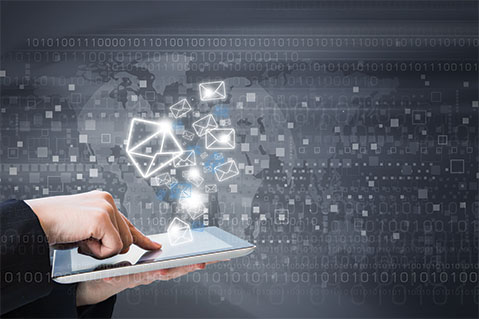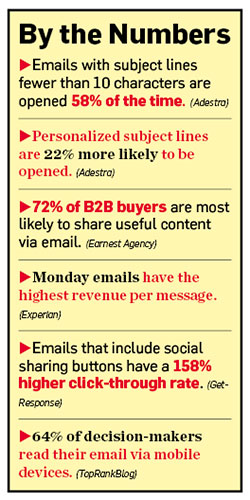April 21, 2016
How to Increase Email Open Rates
Data shows that people open only 18% of emails from marketers. Here are eight concrete strategies to help your company beat the odds and stand out in customer in-boxes.

The decision to double-click on an email can be rather impulsive. Time of day, subject line messaging, sender name and topic can all come into play.
But, usually, it’s more of an impulse. Marketers have just a second or two to grab a prospect’s attention and get them intrigued enough to open an email. And the odds are against you, as multiple studies show that email open rates for marketers today reside south of 20% – and are most likely getting worse, not better.
“When tracking your open rates, benchmark against yourself, not others,” says Lauren Smith, content marketing manager for Litmus, a company that specializes in email testing and marketing analytics. “While external benchmarks are great for looking at trends, they vary across industries, so they shouldn’t be taken too seriously. It’s your data that you should be looking at.”
Smith says your goal should be year-over-year improvements to your email metrics. How can you achieve those gains? Here are eight ways, along with advice for developing content that will get noticed.
It’s All in a Name
Whatever you call your marketing emails, don’t call them e-blasts. This isn’t just about semantics – what you call your emails can actually dictate your approach to how you send them. Chances are, if you’re calling your emails blasts, you’re blasting them to everyone indiscriminately. That’s a mistake.
“There is a stigma nowadays behind that word that most people find unattractive,” says Macaulay Hammond, senior account executive at San Antonio Magazine. He recommends calling your mass emails “e-newsletters” or “e-notes” to put the emphasis on content.
Also, instead of spamming everybody, create set lists to share new products, sales specials and other info that makes sense for your targets. You can tailor each list by market, preferred products, loyal customers or whatever designations best fit your business needs and your customers’ needs.
Recognition Is Key
Most people’s inboxes are set up to see senders’ names before any other information. For this reason, make sure your email name is set to one that your contacts recognize. “It can confuse clients if the name and email address you use for your e-newsletters isn’t the same as what you regularly use,” says Debbie Mrazek, owner of consultancy The Sales Company.
Mrazek adds that it can be smart to create a separate email address just for dispatching e-newsletters, but customers should immediately recognize your name when scrolling through their inbox. Regardless of age or industry, we are all more likely to open emails from people we know and trust.
Craft Smart Subject Lines
Studies show about 33% of people open emails based on subject line alone. “Keep in mind buzzwords like ‘new,’ ‘best’ and ‘exciting,’” says Hammond. “Use words that grab your audience’s attention quickly.”
Indeed, your emphasis should be on getting to the point as quickly as possible. “I get down to business,” says Mayada Sayed, social media integration producer at Middle East Broadcasting Networks, a nonprofit news organization. “I say what I want in the least amount of words possible to not waste the recipient’s time or, more importantly, trust. I personally wouldn’t waste my time reading an email that has a fancy subject that has nothing to do with the content of the email.”
It can help to personalize subject lines for particular groups or individuals as well. Amy Joyce, a senior technical editor at Capital One Financial Corporation, says that’s exactly what her company does. Plus, they reel people in with deals. “The subject lines are short, concise, almost always use a customer’s name and sometimes emojis,” says Joyce. “Because Capital One is a bank and they have credit cards, advertising the special offers is the name of the game.”
Smith warns against subscribing to any “magic formula” and advises testing out different kinds of subject lines for your customers. She recommends A/B testing to determine what sticks with your audience – questions or statements. “Test your subject lines, then test them again, and then test them again,” she says.
 Inform, Support & Entertain
Inform, Support & Entertain
Be sure to give your readers something of value. That could be original articles about the power and ROI of promotional products or a beautiful gallery of top items for a particular industry or program. Maybe you link your emails to webinars or send coupons and promo codes. Think about how you can leverage your content to build trust and sales over time.
“Your emails must focus on your customers and their specific market,” says Harry Ein, owner of Perfection Promo, an iPromoteU (asi/232119) affiliate. “The content has to have something that relates to their industry. I’m really looking for suppliers’ emails to get my attention. Many of those emails get deleted right away. But the ones with a unique product and unique delivery pique my interest.”
Smith believes the message and details need to be worthwhile. “Educational and insightful content works best for e-newsletters,” she says. “People subscribe to emails to learn. Whether it’s to hear more about a product, keep up with the news or get best practice tips for digital marketing, people subscribe to newsletters to learn.”
For a good example, consider digital publisher FierceMarkets’ popular newsletters. FierceHealth, a daily newsletter for health-care executives, runs original reporting on issues health-care executives want to know about, from reform to providers to fraud. Stories like “Three Ways to Make Nurses More Culturally Competent” and “Women Leaders Could Boost Hospital Profits” are written just like news articles.
“We have a bunch of groups, including Enterprise, Biotech, Life Sciences and Health Care, with sub-newsletters of their own,” says Zack Budryk, associate editor of FierceHealthcare. “Within health care, we have separate newsletters for general health care, health finance, health IT, health insurance and physician practices.”
Similarly, you could create promotional product content like: “5 Great Thank-You Gifts” or “How to Develop a Wellness Program” and include those articles in emails that are couched as newsletters.
Be Personable, But Succinct
Mrazek suggests writing in a way that’s authentic. Your tone should be conversational but professional and, most of all, sound just like you. “We all remember English class,” she says. “Writing very proper, formal prose is what we’re taught to do, but when people write that way, they don’t allow their personality to shine through.”
Mrazek believes personality is what sells. “People buy from people they know and trust,” she says. “If you write in a way that’s not authentic and doesn’t demonstrate your voice, then I can read it and I can get it, but how does that make you different from the other guy? Being personable can be one of your biggest strengths.”
You don’t have to unload a stream of consciousness to convey your personality, though. Again, respect your customers’ time. “It should not be like War and Peace,” says Mrazek. So, keep it brief. If you absolutely need more than a couple hundred words to make your point, link to an external site for customers to read more.
Opt for Simple Design
When it comes to email design, Ein says, it should be as clean as possible.
Most readers prefer basic designs with a couple of quality pictures that pop. Do some quick studying on the principals of graphic design to inform your decisions on typography, color and picture placement. If you don’t have in-house photography options, pull stock or rights-free images from the Web and credit them as necessary.
One garish e-newsletter with flashing words can be enough to turn customers off to future communications, so choose wisely. In this case, looks matter. The worst thing you can do is send an email that takes too long to load or won’t open because it’s cluttered with Flash animations.
Timing Counts
You know how some clients start placing orders for holiday promo products in November and get mad when they have to pay rush fees? These are the very clients you need to ping in July. Put their minds on holiday-themed promotional products earlier and they will be eternally grateful.
“Think of it like an editorial calendar,” says Mrazek. “Use timing as a strategy for your email or blog or the way you communicate with your base.” Anticipate when your customers will want or need promotional products and reach out to them early with special offers.
Experiment & Expand
It’s OK for your emails to change over time. In fact, it’s probably a good sign. “We started focusing on one story and going with that,” said Sonia Sanchez, marketing communications manager for Pearl Law Group, an immigration law firm. “Then we just got more specific about the title, so that people quickly got what the story was going to be about.”
But don’t stop there. “If you’re solely using emails to highlight your products and services, chances are your open rates are on the decline,” says Smith. “You should have a balance of helpful outreach, like providing your subscribers with how-to guides or informational webinars and promotional messaging.”
Keep evolving and innovating as well. “Email is priceless,” says Mrazek. “It’s not the only way, but it’s part of the recipe.”
– Email: stoddard.christine@gmail.com; Twitter: @asicentral